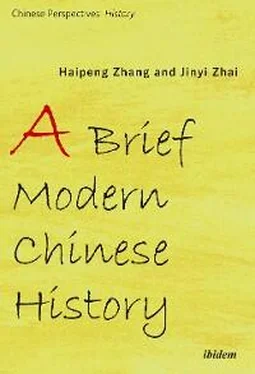The Taiping Army proceeded to capture Yong’an, the first city that they had successfully captured. More than 37,000 Taiping soldiers marched into Yong’an, where Hong laid out a set of rules and regulations and awarded his generals prestigious titles. As the commander of the central army, Yas was named the East King. Xiao was given the title of the commander in chief of the Front Army Corps and declared the West King. Feng was made the commander of the rear guard and the South King. Wei was appointed the commander of the right army and the North King, while Shi was made the commander of the left army and the Wing King. Hong stipulated that the East King was superior to all other kings. The Qing army tried to take Yong’an; however, they failed to defeat the Taiping Army in large part due to a lack of coordination amongst the top generals. Then, in April, 1852, the Taiping Army successfully broke the Qing encirclement and annihilated more than 4,000 of the enemy. Four commanders of Qing’s army were killed in action.
The Taiping Army then marched on Guilin. When approaching the walls of Guilin, they had grown into a huge army of 50,000 soldiers. However, they failed to capture Guilin, despite capturing one of Qing’s top generals. The rebels then headed north and took Quanzhou, after which they charged toward southern Hunan. This resulted in Feng, the South King, dying in battle. In the following four months, many poor peasants and members of secret societies joined the Taiping Army bringing its numbers to 100,000. Xiao, the West King, was killed later that year in September, after attacking Changsha.
After the death of Xiao, Hong and Yang decided to lead all of their troops northward to Changsha. At the same time, Qing’s army, which numbered more than one hundred thousand soldiers, set its sights on Hunan. The Taiping Army could not take Changsha. Then, in late November, 1852, they discontinued their attack on Hunan deciding instead to push northward to Hubei. It is particularly noteworthy that Hong built the Taiping navy by recruiting thousands of sailors and boatmen.
After two months (December, 1852–January, 1853), the Taiping Army captured Hankou, Hanyang and Wuchang, all Wuhan towns. Wuchang was then the capital city of Hubei and one of the best-known cities in China. The conquest of Wuhan displayed the full power of the Taiping Army. The army then moved east toward the Yangtze River. At this point, the number of Taiping soldiers exceeded 500,000 and many Wuchang residents joined the Taiping Army. 4As they proceeded eastward, the Taiping Army divided into two groups. One group was headed by Hong, the Heavenly King, and advanced by sea. The other group was headed by generals such as Lin Fengxiang and Li Kaifang and they made their way forward by land. Some reported that the Taiping troops were the most gallant. 5
In February, 1853 the Taiping army defeated Qing’s army in eastern Hubei and then went on to capture Jiujiang (in Jiangxi) and Anqing (in Anhui). One month later, the Taiping soldiers stormed their way into Nanjing, the most strategic and important city in southeast China. Soon Zhenjiang and Yangzhou, two famous cities of Jiangnan (south of the lower reaches of the Yangtze River), were also taken by the Taiping Army. Hong entered Nanjing in a grand dragon boat and established it as the capital of his Heavenly Kingdom of Great Peace. Ten days later, the Qing army set up its Southern Barracks on the eastern outskirts of Nanjing. Qing’s Northern Barracks were established outside of Yangzhou, a strategic city north of Nanjing. These two huge military camps posed a great threat to Nanjing and Zhenjiang in particular. For this reason, the Taiping Army was not able to extend to the more wealthy southern Jiangsu. Regardless, Yang, the East King, second only to the Heavenly King (i.e., Hong), decided to launch the northern and western expeditions.
The goal of the northern expedition was to capture Beijing and overthrow the Qing dynasty. The commanders of the northern expedition army were Lin Fengxiang, Li Kaifang and Ji Wenyuan, all the bravest and most brilliant generals of the Taiping Army. The Northern Expedition Army (NEA), which was comprised of more than 20,000 soldiers, was renowned for its combat effectiveness, unparalleled in all of the fifty Taiping brigades. The NEA’s vanguard landed at Pukou in May, 1853 and crushed Qing’s defending force. It then captured cities such as Chuzhou. The NEA’s rear guard suffered a setback. When informed about this, Yang, the East King, sent out an order that the NEA must achieve its strategic goals as soon as possible as they were unable to provide more support. 6Despite this news, the NEA still marched forward courageously and entered Henan, where it attacked the enemy without mercy. By late June, the NEA had swelled to a huge army of about 40,000 men and continued north across the Yellow River. However, a very dangerous situation lay ahead for the soldiers.
The NEA spent two months besieging Huaiqing (present-day Qinyang in Henan), but failed to capture the city. As more of Qing’s armies arrived, the NEA had to retreat to Shanxi. The failure of the Huaiqing campaign had a serious impact on the Taiping Army’s northern expedition and it suffered heavy losses. Worst of all, it wasted fifty-six days there. However, in late September it won a series of battles against the Qing army, encouraging the hope that it would be able to launch an attack on Beijing, Qing’s imperial capital, before winter. Yet the NEA was exhausted and couldn’t go further, needing to rest in Shenzhou, a prefecture south of Beijing.
It was rumored that the Taiping Army had captured Dingzhou, which was close to Beijing. This news appalled the imperial court. Emperor Xianfeng (r. 1850–1861) appointed a prince and Sengge Linqin, one of the most renowned Qing generals, to defend Beijing at all costs. Sengge led an army of four or five thousand men to Zhuozhou, a prefecture south of Beijing. At the same time, another high commander stationed his troops in Baoding, Beijing’s southern gate. Qing was determined to fight the Taiping Army to the death. However, the NEA did not head straight for Beijing but instead pushed eastward toward Tianjin. In late October, the NEA arrived in Yangliuqing, a town in Tianjin. By then, the NEA had nine brigades and 30,000 soldiers in total.
The NEA was stationed there for more than three months. It was in this period that the northern expedition began to face problems. The biggest threat at this time was not the opposing forces but the bitter cold of winter. Most of the NEA’s soldiers came from the south and did not know how to protect themselves from the cold. As a result, the NEA lost half of its elite soldiers due to bad weather. Quite a few Taiping soldiers froze to death. In February, 1854, the NEA began to retreat southward and the NEA’s commanders desperately hoped for reinforcements.
In December, 1853, Nanjing arranged relief troops. However, of the sixty thousand soldiers recruited, many were not well-disciplined, nor did they want to head north. By the following April, the reinforcements were utterly defeated. In June, 1854, Nanjing made a second vain attempt to save the NEA. Li Kaifang and Lin Fengxiang, the NEA’s two leading generals, were defeated and captured in the first half of 1855. They were later taken to Beijing and brutally executed. A leader in the Taiping Army reflected that the failure of the northern expedition had a bad effect on the entire rebellion.
The Taiping Army’s western expedition aimed to capture the entire middle region of the Yangtze River and turn the region into a base to provide protection and supplies to Nanjing. Unlike the NEA, which was particularly good at fighting on the ground, the Western Expedition Army (WEA) made the best of its navy. In June, 1853, the WEA left Nanjing with a fleet of more than 1,000 ships. It captured several cities in Anhui and Jiangxi and attacked the strategic city of Nanchang. While attacking Nanchang, the WEA tried its utmost to transport grain to Nanjing. Lai Hanying, the WEA’s commander, underestimated the enemy, and the WEA finally failed to take Nanchang and had to end its siege in September. Lai was dismissed and replaced with Shi Dakai, the Wing King. The WEA began its retreat in October and started to attack Hubei.
Читать дальше












